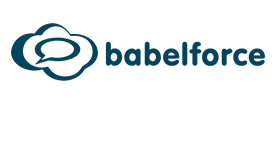
Buckley
Pierce Buckley at babelforce looks at the 5 facts that show the voice channel will remain crucial for customer service and will continue to gain relevance over the next decade.
Voice is the oldest service channel – does that mean it’s due to die out? No – in reality, the voice channel is going to continue gaining relevance in the next decade.
Telephony is old technology. Bell’s first patent was over 150 years ago. What that tells me is: telephony has stood the test of time.
That ongoing relevance is based on one thing: a phone call is the best way to have a natural conversation in a customer service setting.
That’s the reason you’ll still be placing phone calls in 2034. But there are a few more reasons that telephony isn’t going anywhere – let’s talk about them.
The Cost of Calls Is Smaller Than Ever
Bottom line – voice costs more than agent service in other channels. And it costs a lot more than self-service!
All the same, cloud-based telephony has slashed the base cost of handling calls. This is old news now, but businesses see a 50-75% cost reduction from switching to VoIP. The widespread move to cloud telephony has also made infrastructure simpler to manage, adding further savings.
Basically, we’ve never had it so good.
In their most recent set of predictions, Gartner said that VoIP costs will continue to decline 3-5% every year. But even more significant than the cost of calls is the value of voice. For retention, for upselling, for research – voice is still the pack leader among channels.
Voice Is the #1 Channel for Important Queries
Customers want to talk on the phone. Period.
Research for Zendesk’s 2024 “Trends” report shows that voice is the favored channel for customers whose topics are “complex or nuanced”.
It’s why 70% of businesses, while preferring digital channels for first contact, use voice for complex queries and escalations.
The Trends report explains that “Voice is carving out a more advanced role, focused on complex and escalated issues.”
That’s certainly my experience in a nutshell. I don’t ‘love’ phone calls. I just love getting my problem solved.
Ah – but what about younger customers? Don’t we have a looming generation of customers who won’t pick up the phone?
Maybe, but you can look at it a different way. We know that it’s the customers with high stakes problems to solve who default to phone calls – people with questions about their mortgage, health insurance, or about high-value purchases.
Ask yourself, are those people more likely to be 20 years old or 50 years old?
The point is that age may not be the determining factor we think it is. Older people just tend to have more pressing challenges to solve!
Digital Services Are Changing What “Call Centre” Means
Think about how a modern customer approaches a problem. They don’t always set out to ‘contact customer service’. Their approach is more exploratory, and begins with investigating options on your website or app.
They’ll encounter FAQs and self-service.
They’ll start chatting with some clever generative AI you’ve embedded on your website.
Then – if they don’t get a solution – they will need to talk to someone.
In many cases, this is a terrible friction point. The self-service journey has failed. Now a new and separate journey begins.
But businesses are more aware than ever that uninterrupted customer journeys and context across all channels are important. They are increasingly willing – and able – to make the link to a live agent voice interaction via an in-app or direct message prompt.
What does that mean for agent service? It takes what has been a chore, and option of last resort… and turns into a natural part of the dialogue with a business.
And the value of that is huge: businesses with omnichannel focus see 91% higher year-over-year customer retention than businesses without.
Voice Budgets Are Increasing. Because There’s Demand.
41% of CX leaders reported plans to increase their voice support budgets in 2024, according to the Zendesk trends report.
And that’s counterintuitive because it’s getting harder to hire agents to run the phone lines; 63% of contact centre leaders are facing staffing shortages.
So why the increased spending on the voice channel? Can you guess?
It’s because people won’t stop phoning.
Well okay, it’s a bit more complicated than that.
More accurately – despite the rise of self-service (which 81% of customers want), there are still factors pushing call volume up in some cases.
So for some organizations that’s caused by a change in the nature of the calls they get.
This happened to the UK’s tax office, which has been inundated with a deluge of voice calls because more people are doing freelance work. Which means more people need help with complicated tax paperwork.
For some organizations it’s a change in the nature of the business itself.
In the UK a number of businesses have closed physical stores and become online only. In that scenario, all the customers who would have opted for face-to-face customer service are probably going to switch to the next best thing: voice-based service.
The global eCommerce market is going to grow by 57.4% by 2029, so for many, voice will become the default option for human-to-human customer service.
You Only Get 7% of a Message’s Emotional Content Via Text
And that’s just one of the limitations of text (in all its digital forms) as a way of communicating.
Ever been in one of those long email chains that gets totally confusing, and ultimately leads to a quick meeting where everything suddenly becomes clear?
Reading and writing is something we learn formally in education. It’s actually not a natural thing for us to do: various parts of the brain get roped in to make it work.
Speech, on the other hand, is something we learn informally from birth.
And sometimes there’s just no substitute for the spontaneity and connection that affords us.
For more information about babelforce - visit the babelforce Website
Call Centre Helper is not responsible for the content of these guest blog posts. The opinions expressed in this article are those of the author, and do not necessarily reflect those of Call Centre Helper.
Author: babelforce
Published On: 4th Jul 2024 - Last modified: 22nd Oct 2024
Read more about - Guest Blogs, babelforce, Pierce Buckley






 babelforce is the composable customer experience platform uniting agents and automation.
Our platform gives you the power to create the customer experiences you’ve always wanted, with tools anyone can use.
babelforce is the composable customer experience platform uniting agents and automation.
Our platform gives you the power to create the customer experiences you’ve always wanted, with tools anyone can use. 








